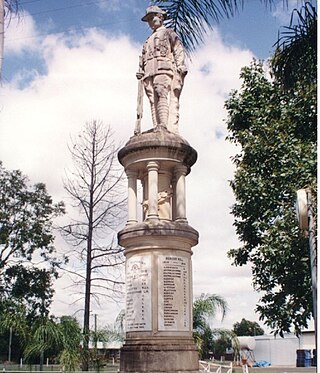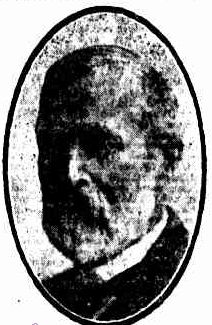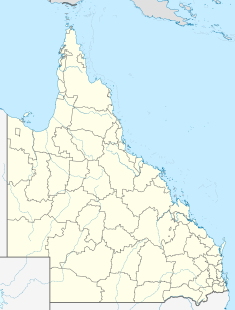
ANZAC Square is a heritage-listed town square and war memorial located between Ann Street and Adelaide Street, in Brisbane, Queensland, Australia. It is a state memorial to the men and women who participated in overseas armed service and is named in honour of the Australian and New Zealand Army Corps. ANZAC Square is adjacent to ANZAC Square Arcade.

Queens Gardens is a heritage-listed park located on a city block between George Street, Elizabeth Street and William Street in the Brisbane CBD, City of Brisbane, Queensland, Australia. It was built from c. 1905 to 1990s. It is also known as Executive Gardens and St Johns Church Reserve. It was added to the Queensland Heritage Register on 21 October 1992.

Adelaide Street is a major street in Brisbane, Queensland, Australia. It runs between and parallel to Queen Street and Ann Street.

The Sydney Cenotaph is a heritage-listed monument located in Martin Place, in Sydney, New South Wales, Australia. It was designed by Bertram Mackennal and built from 1927 to 1929 by Dorman Long & Co. It is also known as Martin Place Memorial and The Cenotaph. It is one of the oldest World War I monuments in central Sydney. It was added to the New South Wales State Heritage Register on 11 November 2009.

The South African War Memorial is an equestrian memorial dedicated to the South Australians who served in the Second Boer War of 11 October 1899 to 31 May 1902. It was the first war in which South Australians fought, and 1531 men were sent in nine contingents, with over 1500 horses to accompany them. Over 59 South Australians died in the war.

The Sir William Glasgow Memorial is a heritage-listed statue of Sir William Glasgow in Post Office Square at 270 Queen Street, Brisbane CBD, City of Brisbane, Queensland, Australia. It was designed by Daphne Mayo and built from 1961 to 1964. It was added to the Queensland Heritage Register on 13 May 2004.

Boer War Memorial is a heritage-listed war memorial at Crescent Street, Gatton, Queensland, Australia. It was designed by William Hodgen and produced by Toowoomba mason William Bruce. It was built in 1908, and was unveiled on 3 August by Governor of Queensland, Lord Chelmsford. The memorial honours four local men who died in or as a result of the war, and is one of only three known Boer War memorials in Queensland. It is also known as the Fallen Soldiers Memorial and the South African War Memorial.

Forest Hill War Memorial is a heritage-listed memorial at Gordon Street, Forest Hill, Lockyer Valley Region, Queensland. Australia. It was built in 1921. It is also known as Forest Hill Soldiers Memorial. It was added to the Queensland Heritage Register on 21 October 1992.

Ma Ma Creek War Memorial is a heritage-listed memorial on the Gatton-Clifton Road, Ma Ma Creek, Queensland, Australia. It was completed in 1920. It was added to the Queensland Heritage Register on 21 October 1992.

Beaudesert War Memorial is a heritage-listed memorial at William Street, Beaudesert, Queensland, Australia. It was built from 1919 to 1921. It was added to the Queensland Heritage Register on 21 October 1992.

Caskey Monument is a heritage-listed memorial at the Toowong Cemetery, 124 Birdwood Terrace, Toowong, City of Brisbane, Queensland, Australia. It was designed and built by William Busby in 1902. It was added to the Queensland Heritage Register on 21 October 1992.

Berry & MacFarlane Monument is a heritage-listed memorial at Sherwood Road, Sherwood, Queensland, Australia. It was built in 1902. It was added to the Queensland Heritage Register on 21 October 1992.

Oxley War Memorial is a heritage-listed memorial at 1218 Oxley Road, Oxley, Queensland, Australia. It was built in 1920. It is also known as Oxley Memorial Park and Oxley Place. It was added to the Queensland Heritage Register on 4 July 2006.

Anning Monument is a heritage-listed memorial at the corner of Hemmant and Tingalpa Road and Boonoo Street, Hemmant, City of Brisbane, Queensland, Australia. It was designed and built by William Busby in 1903. It is also known as Hemmant Boer War Memorial. It was added to the Queensland Heritage Register on 21 October 1992.

James Laurence Watts (1849–1925) was a sculptor in Queensland, Australia. He was one of the pioneer sculptors in Australia and his works appear in many Queensland public buildings and places.

Booval War Memorial is a heritage-listed memorial at Green Street, Booval, City of Ipswich, Queensland, Australia. It was built in 1919. It was added to the Queensland Heritage Register on 21 October 1992.

The Boer War Memorial is a heritage-listed memorial at Warwick Street, Allora, Southern Downs Region, Queensland, Australia. It was built from 1904 to 1940s. It is also known as Queen's Park and War Memorial Park. It was added to the Queensland Heritage Register on 21 October 1992.

T J Byrnes Monument is a heritage-listed memorial at Palmerin Street, Warwick, Southern Downs Region, Queensland, Australia. It commemorates Thomas Joseph Byrnes, the short-lived Premier of Queensland who died in office in 1898. It was designed by Andrews Bros (Sydney) and built from 1901 to 1902 by Andrew Brothers (Sydney). It was added to the Queensland Heritage Register on 6 January 1999.

Ipswich Railway Workshops War Memorial is a heritage-listed memorial at the North Ipswich Railway Workshops, North Street, North Ipswich, City of Ipswich, Queensland, Australia. It was designed by Vincent Price and built in 1919. It was added to the Queensland Heritage Register on 21 October 1992.

Dalby War Memorial and Gates is a heritage-listed memorial at Patrick Street, Dalby, Western Downs Region, Queensland, Australia. It was designed and built in 1922 by Harry Shill and British firms. It was added to the Queensland Heritage Register on 21 October 1992.























